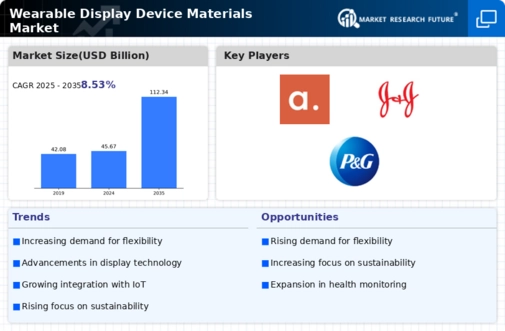Market Analysis
In-depth Analysis of Wearable Display Device Materials Market Industry Landscape
The Wearable Display Device Materials Market is characterized by a range of dynamic factors that influence its growth and evolution. Understanding these market dynamics is crucial for stakeholders to navigate the industry effectively. Here's an exploration of the key dynamics:
Rapid Technological Advancements: Continuous advancements in display technology drive innovation within the wearable display device materials market. Manufacturers are constantly developing new materials with improved optical properties, flexibility, and durability to meet the evolving demands of wearable devices such as smartwatches, augmented reality (AR) glasses, and fitness trackers.
Increasing Demand for Wearable Devices: The growing popularity of wearable devices across various industries, including consumer electronics, healthcare, fitness, and gaming, fuels the demand for wearable display device materials. Consumers seek lightweight, compact, and visually appealing devices, driving manufacturers to invest in advanced materials that offer superior performance and user experience.
Focus on Lightweight and Flexible Materials: With the demand for wearable devices emphasizing comfort and convenience, there is a shift towards lightweight and flexible display materials. Materials such as OLED (Organic Light Emitting Diode) and AMOLED (Active Matrix Organic Light Emitting Diode) offer flexibility, enabling the development of bendable and stretchable displays for wearable applications, enhancing user comfort and device aesthetics.
Integration of Advanced Functionalities: Wearable devices are increasingly incorporating advanced functionalities such as biometric sensing, health monitoring, gesture recognition, and AR/VR (Augmented Reality/Virtual Reality) capabilities. This trend drives the demand for innovative display materials capable of supporting high-resolution displays, touch sensitivity, energy efficiency, and advanced optical features, thereby driving market growth.
Customization and Personalization: Consumers are seeking personalized and customizable wearable devices that cater to their unique preferences and requirements. This trend influences the demand for display materials that enable customization of display size, shape, color, and interface, allowing manufacturers to offer differentiated products and enhance user engagement.
Health and Fitness Monitoring Applications: The integration of health and fitness monitoring features in wearable devices drives the demand for biocompatible and skin-friendly display materials. Manufacturers prioritize materials that are hypoallergenic, breathable, and resistant to sweat and moisture, ensuring comfort and safety during prolonged wear, thereby driving market demand.
Regulatory Compliance and Safety Standards: Compliance with regulatory standards and safety requirements is paramount in the wearable display device materials market, particularly for materials in direct contact with the skin or eyes. Manufacturers must ensure that materials meet relevant regulatory guidelines for biocompatibility, chemical safety, and electromagnetic radiation, thereby instilling consumer trust and confidence in wearable devices.
Cost Considerations and Price Competitiveness: Cost considerations and price competitiveness play a significant role in shaping market dynamics, particularly in price-sensitive consumer markets. Manufacturers strive to develop cost-effective display materials without compromising on quality, performance, or durability, thereby addressing the diverse needs and budget constraints of consumers.
Supply Chain Management and Global Sourcing: The wearable display device materials market relies on efficient supply chain management and global sourcing strategies to meet growing demand and ensure product availability. Manufacturers collaborate with suppliers, distributors, and contract manufacturers worldwide to secure a stable supply of raw materials, components, and finished products, mitigating supply chain risks and disruptions.
Emerging Market Trends and Consumer Preferences: Emerging market trends, consumer preferences, and lifestyle changes influence the demand for wearable display device materials. Factors such as the adoption of wearable technology in healthcare, the rise of smart fashion and accessories, and the convergence of fashion and technology drive innovation and create new opportunities for materials suppliers and device manufacturers.






Leave a Comment